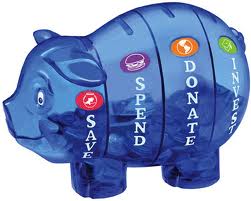Financiation: The Good and Bad About Allowances for Children
The Good and Bad About Allowances for Children
Children and money. The idea about allowances started back around 1831, when Lydia Maria Child became a strong advocate for promoting family values and teaching children about money. (Lydia Maria Child came up with the poem “To Grandmother’s House We Go”) most child rearing experts believe children should get an allowance appropriate for their age and not related to the responsibility of doing chores around the house.

Financial experts believe allowances give children better skills at handling money. There is debate among others who feel that the allowance does not help children learn to manage their money. The proponents of allowances believe kids between the ages of 3-5 are ready for an allowance.
It is a tough decision about how much to give your child. Some believe a weekly allowance equivalent to $1 per age per week is sufficient. Some think that the allowance should be determined by what the parents think the children will do with the weekly allowance. It may depend on how much your children have to take responsibility regarding all of their spending.
If they have to buy their own clothes, and their own school lunches the allowance needs to accommodate them for these costs. If the allowance is just for their social spending, you need to consider how much independence you want them to have over free wheeling spending options.
Teaching Children Fiscal Responsibility
Part of teaching them fiscal responsibility will come from giving them more control over their spending choices. As a family, it is advisable to choose what the purpose of the allowance is, and use that as part of the determining giving factor.
Most child psychologists believe the allowance should not be tied to family chores. The idea of chores, these experts think, helps children learn to share family responsibilities. Also if you want them to continue to be doing chores around the house, as they get older, they may not be cooperative when they have other income that may come in from gifts or jobs.
Some parents choose not to give an allowance at all. As the child needs things, the parents pay for them. Children can still be taught enough about the value of money this way through the choices of how the money is spent.

The Great Allowance Debate
The debate rages on, with some experts believing that it is allowances that teach financial restraint to children. Giving an allowance, how much you give, and what it is used for is all personal family choices. Allowances or not, children need explanations about money so they can handle it properly in the future.
Ultimately It is what you teach your children, money itself can not teach children anything. Give your children, your time and patience, so they will have the confidence to handle money in a smart and educated manner.
Often parents think they can’t afford to give an allowance to their kids. If you want to give your child an allowance, but feel you can’t afford it, you really can. Think of the money you will give your children as an allowance as the same money you would be spending on them. The only difference is that, they are spending the money instead of you. As long as you are guiding them, the money won’t be spent on needless items. You will be using the lesson of an allowance as a way to share your thoughts and values about money with your child. This is what is important for them to learn.
What Do You Want Your Child to Understand About Money?
One of the biggest misconceptions about an allowance is that some parents cannot afford to give their children "extra" money. However, if you look at an allowance from a different angle, every parent can afford it. An "allowance" is basically money that you're going to spend on your child anyway, just given in a different form. Instead of paying for things at the time your children want them, you pay them an allowance and let them decide how to spend the money. The ultimate goal of an allowance is to teach children to distinguish between needs and wants and to prioritize and save--a difficult lesson that will be needed throughout life.
Teach Your Kids About Money
Age Appropriate Tips
Whether you give an allowance or not, here is some age appropriate tips to help them learn about money:
For ages 3-5 years old you can start to teach them about coins and their values. Help them recognize how much money each coin represents. Your discussions could be about what we do with money and how money buys things
5-6 year old can be introduced to savings accounts, what it means to giving to charity, and how money is used to pay bills, etc.
7-8 year old can be taught about managing money. They can learn how to divide their money into saving, charitable donations, and, and things they want to spend money on.
9-12 years old can be given more responsibility over what they do with their money. Some can be given the freedom to buy their own clothes, go to the movies, and other msc expenses, kids of this age have.
In the teen age years. your child should have the freedom to make their own choices, within limits, about what they will choose to buy. As they approach the age of working, you want them to be money mindful, so they make judicious financial choices. It is important to give your child autonomy on spending at this age.
It is Better Your Child Makes Mistakes with Money When You Can Teach Them
Sometimes, the best way to teach kids about money is to let them make their own mistakes, and good decisions. It is important to teach kids to save money and to also make good buying decisions. It might be a good opportunity to set up a bank account to encourage kids to save and put money away. To encourage your child to donate some of their money, help them pick out a charity that interests them like the local pet shelter. If they don’t donate money, perhaps they can donate their time, if they are old enough.
Your decision has to work for you and your family. It has to be a good fit for it to work effectively. You must think about what works best for you. Whatever you decide, be sure that the family as a unit makes a decision that works for them. If an allowance is connected to household chores, set the rules for what your expectations are and be clear about the consequences are if they are not done. Consistency is very important. If you give chores, pay them as you agreed. If you give them an allowance, be sure you give it to them regularly on the day promised. Be the best example you can be for your children in many ways.









